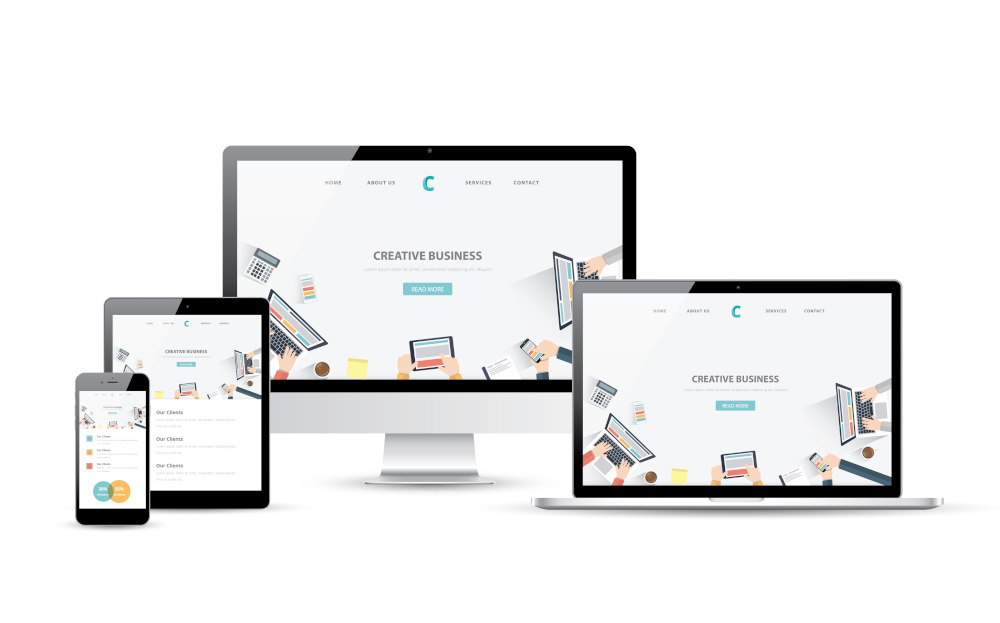
by Marelise da Silva | Jul 8, 2016 | Website Design
If you are thinking of designing your company’s website, or are looking for ways to improve it, it can be quite intimidating when you think of the vital needs that must be fulfilled – the expectation of your stakeholders and the needs of your target audience. Here are some tips to creating great website design, that you could try out:
- Start your design in shades of grey – turn your wireframe into visual design with grey tones at first, add your photography, then the colour elements one at a time. This will prevent an overly busy website and will help you highlight the items that need it.
- Choose web fonts for your corporate style guide – Google Fonts is a good place to start looking for a suitable font. Define its usage in your style guide and give your website a more professional look.
- Use Keynote (Apple’s version of PowerPoint) to create rapid page prototypes – you no longer need Photoshop to create prototypes of your landing pages or call to actions. Keynote has user interface design templates for wire-framing, prototyping and testing mobile and web apps.
- Simplify your navigation – this can actually help to guide people more quickly to your most productive content. Eliminate dropdown menus as well as the number of links in the header or sidebar of your website.
- Make your social media icons less prominent – keep people on your website for longer, rather than encouraging them to link to your social media platforms. Social media should drive traffic to your website, not the other way around – reduce the icon sizes and put them in the footer.
- Remove sidebars – although a very popular design trend for the last decade, sidebars can actually be distracting. Leaving them out allows the reader to focus on the article or blog and makes them more likely to follow the call to action at the end.
- Get rid of the slideshow – although it’s an easy way to get lots of information on your home page, most people don’t stay on your page long enough to read all the slides. Focus on your core functionality and promote that.
- Use Pinterest to create mood boards for inspiration – group favourite images, colours, patterns or layouts to help you come up with ideas. The great thing about using Pinterest is it will share the boards of other designers who may have collated a lot of similar images already.
- Use white space – it makes things easier to find. Not every inch of the screen needs to be filled at all times. White space and simplicity are top trends of the moment, so your readers will appreciate a quieter space.
- Increase your font size, especially for headings – tiny text and too much of it is hard to read on screen, so use larger font sizes to emphasise important blocks of content. Consider increasing your font size in general; it could be the key to keeping your readers engaged for that bit longer.
Try out some of these design hacks on your website design or redesign, or if you’re still baffled, ask for help. We have loads of experience in website design and would love to assist in creating a company website that pulls in the right kind of traffic.

by Francois Muscat | Jun 2, 2016 | Content Marketing, Social Media Marketing, Website Design
It’s a fact that mobile usage has overtaken the desktop, yet mobile advertising is still a largely untapped medium. One of the main reasons for this is the speed – mobile users are impatient and if a page fails to load in under five seconds, you’ll lose the traffic. But all is not lost – Facebook has introduced Canvas, a new mobile-only product that allows businesses to use storytelling to showcase their products.
Psychology shows that emotions are far stronger in the buying process than information, across all types of advertising media. In addition to swaying the buying decision, customers have more loyalty to a brand, based on how it makes them feel. So it’s simple really, create an advert that’s eye-catching, beautiful and emotive, using content and interactive elements that work instantly, on a mobile device. That’s quite a tall order, but one within reach if you explore Canvas.
Canvas uses Facebook Instant, so there’s no delays and waiting for pages to load. It’s ideal for consumer facing brands where emotions play a big role. Interactive media, delivered at high-speed is the perfect way to introduce new brands, products and offers to people. By creating a memorable advertising experience, you can really highlight features of your offerings and increase the user engagement.
Early statistics have pointed to an increase in mobile engagement when using Canvas, which is awesome when you consider the attention span of your average mobile user. It also offers the ability to incorporate a single clickable CTA that leads the user to your website. Another advantage is that using Canvas costs no more than your normal News Feed ad on Facebook. You can create ads easily using the self-service tool, dragging and dropping design elements.
Unlike a static ad that you see and then click on, or the annoying auto-play videos, Canvas gives the user the opportunity to interact with the ad, before clicking on the CTA. Using the creative specs provided by Canvas, you need to build a storyboard to plan the interaction – almost like creating an app or building a mini website.
It’s an amazing way to engage mobile users like never before and to boost awareness of your products or services. For more on the tricks of the trade when it comes to mobile marketing, contact us today!

by Marianna Muscat | Jun 1, 2016 | Content Marketing, Copywriting, Digital Media Marketing, Social Media Marketing, Website Design
It’s a pretty common thing these days to spot spelling mistakes and bad grammar when you’re surfing the internet – adverts, blog articles, website content – there’s no one area better or worse than another. While some people may not notice spelling or other errors, a lot of people do, so just how big a deal is accurate content?
There’s nothing wrong with using a conversational tone, especially in blog writing, but using slang, txtspk and sloppy grammar is just unacceptable. Studies have shown that people are less likely to engage with companies that post error-riddled sales copy, as they feel it undermines the credibility of the company (are they just as careless with their orders, accounts or delivery?). Creating any kind of negativity towards your business is a sure-fire way to kill sales, so why do it? With online companies like Grammarly, offering automated proofreading services, it’s a mystery why there is still so much room for improvement in online writing.
It’s been shown that over 40% of web users are influenced by spelling or grammar blunders in online content. When you sell or communicate online, most of the time it’s done by using the written word, so it’s quite obvious the damage it can do to your conversions. Questions have been raised over the importance of correct spelling and grammar in social media interactions, since it’s a more relaxed medium for communication, especially when using platforms like Facebook. That said, any business using Facebook to increase their exposure, should treat it with as much importance as their website or LinkedIn profile.
There are simple ways to improve your content, which can make a real difference to your bottom line. These are:
- Read your content backwards: this disrupts the natural flow of how you perceive things, so it forces you to read every word, making misspelled words easier to spot.
- Ask someone else to read your writing: a friend or co-worker who has not been working on the same piece of content for hours will spot inaccuracies that you will miss time and time again.
- Read your piece out loud: some errors can be more easily heard than seen, so reading your writing out loud forces you to listen.
- Use software like Grammarly: it really does make a difference. While you may not agree with all their suggestions, it does help to sharpen your eye.
Whether or not you agree on the importance of accurate writing, think of a website with sloppy grammar and lots of error. Would you be happy to give them your credit card details?
Didn’t think so.
If you’d like to know more on content marketing or need help creating the perfect content for your website or social media posts, contact us – we’d love to help!

by Marelise da Silva | Dec 10, 2015 | Social Media Optimization, Website Design
Humans are visual people, so it’s no surprise then that when it comes to social media, images and videos are king. Of course, not every image will get shared. For the purposes of social media marketing, there are some design tricks you can use to ensure your images are highly shareable. Here they are.
- Make use of handy online tools
Great images don’t necessarily need the latest version of Photoshop to be sharable. Using an online tool such as Canva, you can create graphics that look fantastic and are formatted perfectly to fit social media platforms.
- Reduce the amount of text
A wall of text is extremely unattractive. An image says a thousand words on its own, so reducing the amount of actual text you use will make your image more eye-catching and therefore, more sharable. This is especially true with social media platforms such as Pinterest, where posts are pinned in a quick moment for their visual appeal. For many, pinning an image doesn’t even have much to do with where the image links to.
- Use high quality images
Whether you took the photo yourself or you bought a stock image, make sure the quality is high. Nothing looks worse than a stretched out, pixelated image. No one wants to share (or Pin!) pictures like that.
- Take advantage of the latest image trends
A quick scan of Pinterest will give you an idea of what kind of image and layout is “in” at the moment. Mountain scenery with inspirational quotes, flat lays of multiple objects and beautiful close-ups are just some of the types of images which pop up under the “Popular” section on Pinterest. Hop on the bandwagon and see your shares go up.
If you would like to find out more about navigating the social media marketing landscape, get in touch with us at WSI OMS. With expertise in online marketing, content, email marketing and more, WSI OMS is ready to assist you with your digital strategy. Contact us now.

by Francois Muscat | Oct 26, 2015 | Website Design, Website Optimization
Plugins are like the bells and whistles of website design. They add shimmer and shine to the basic function of a WordPress site, and while there are thousands of free and pay-for plugins out there, we’ve compiled a list of six of the best.
Here are the top six must-have plugins:
- WordPress SEO
The first, and most important, plugin is WordPress SEO (Site Engine Optimisation). This is crucial to all ecommerce businesses. Why? Because without it users won’t get to your site. It puts your ecommerce business on the map, and preferably at the top of the list. Research shows that most users visit the top five listings in a search, so if you’re going to use a plugin, use this.
- Google Analytics for WordPress
This plugin allows you to track all aspects of your ecommerce site. It allows you to see who visits your site, where they’ve come from and what device they are using. Besides informing you about your audience, it gives you comprehensive reports on bounce rates, behaviour, conversion and real time, among other things.
- Mailchimp widget
Email marketing is an inexpensive way to drive traffic to your website and garner new customers. The Mailchimp widget allows you to easily drop an “email sign-up” onto a sidebar, making it a simple process for customers, and also for you to manage your contacts.
- NextGen Gallery
Pictures make or break a site and perhaps that’s why this is the most popular WordPress plugin. The NextGen Gallery allows you to have control over the images that you add to your site. You can create galleries and albums with various options available, including a lightbox effect and style and size edits, plus loads more.
- Contact Form 7
This is how you add forms to your site, even if you’re not an HTML whizz. The plugin allows you to customize the form to suit your needs and manage multiple forms simultaneously. It’s simple, smart and easy.
- Share this
Share this helps you increase social activity on your site by making it easier for visitors to share your content – they simply click a ‘share this’ button. This plugin gives you access to several social media platforms too, including Twitter, Facebook and Pinterest.
Need help designing or developing an ecommerce website? Then contact WSI OMS today.

by Marelise da Silva | Sep 17, 2015 | Website Design, Website Development
Several web development companies have emerged over the recent years after people and businesses have realised the effects of websites in business ventures. However, not all web developers have the necessary skills, experience and abilities to develop a great website for your business. Nevertheless, a web developer is amongst the most important service providers you can hire for a business. This is because the developer will create the face of your business online and enhance its virtual interaction with customers. To hire a great web developer, you need to consider certain factors.
Longevity
Consider the period for which the web developer has been in the industry. A developer who has been in the industry long enough has acquired the necessary expertise and experience. This is because if a web developer had not been providing good services, customers would have been dissatisfied and therefore they would not have acquired the necessary profit for sustaining their business. Thus, they would no longer be in business.
Interview the developer
Before hiring a web developer, ask them questions that will enable you to determine their suitability for your web development project. Do not ask the developer questions they can easily answer, instead, ask open-ended questions then listen to the answers they give you. Consider the response that the developer gives and how they explain technical terms before hiring them.
Cost-effectiveness
Consider the value you get for the service you hire. A developer might charge you a low price, but offer poor quality service. Therefore, consider the quality of the service you are paying for. Choose a web developer who has an established reputation of offering the most cost-effective services.
Technical support
After offering the service, a web developer should not disappear completely. They should stick around to provide technical support where and when necessary. Therefore, choose a web developer who guarantees and offers after-service support.
With the number of companies that offer web development services increasing by the day, it is not enough to just hire a web developer. Strive to hire a great web developer.
If you are looking to hire an experienced web development company then talk to us today.







